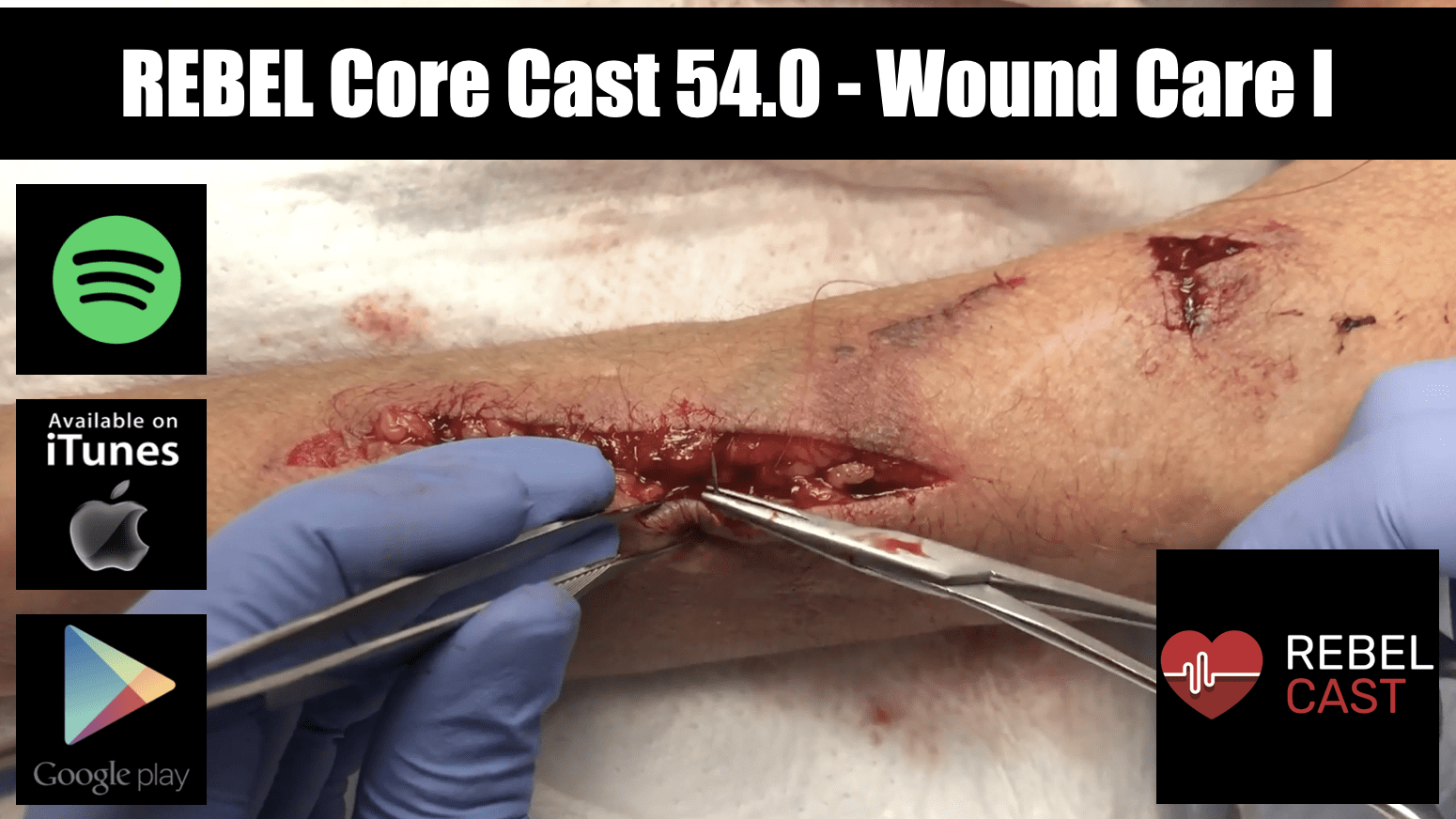
 Take Home Points
Take Home Points
- FBs are a very common complication of wounds.
- X-ray is poor at detecting foreign bodies
- US is a tremendous tool and be used dynamically at the bedside to assist w FB extraction
- Prophylactic antibiotics are not routinely recommended
REBEL Core Cast 54.0 – Wound Care I – Foreign Bodies
Click here for Direct Download of Podcast
How common are Foreign Bodies?
- 11 million patients present to the ED with traumatic wounds every year
- Approximately one patient every 3 seconds
- 1 in 7 wounds (7-15%) may contain foreign bodies
- We miss 1/3rd (38%) foreign bodies on initial evaluation.
What Complications arise from foreign bodies?
Delays in treatment or missed foreign body may lead to:
- infection
- delayed wound healing
- inflammation
- loss of function
Missed FB is a common reason for malpractice claims secondary to complications in wound care management.
- The payouts are small
- But the impact is significant due to large number of patients
- Claims due to wound care complications netted 3% to 11% of all dollars paid out
How do we evaluate wounds for foreign bodies?
A detailed history and thorough physical exam are vital
- Typically our patients can reliably tell the mechanism and type of foreign body
- Altered patients may be unable to provide Information
- These situations can provide a diagnostic dilemma
HPI: Obtain Information:
- Type of foreign body
- Mechanism of injury
- Tetanus
- Past medical history: assessment of high-risk individuals requiring antibiotics
Physical exam:
- Note range of motion,
- Tendon function
- Signs of infection
- Neurovascular exam: sensation, pulses, cap refill
- Palpable foreign body
- Skin discoloration
Considerations for Imaging:
- Inability to completely visualize the depth of wound
- Deep wounds caused by glass
- Patient believes there is a foreign body
- Small, thin, breakable, or brittle object
- Object easily be buried beneath the skin
- Severe wound pain
- Painful mass
- Discoloration under the skin
- Missing portion of the object
- Penetration through rubber sole
How good are X-rays for assessing foreign bodies?
X-ray:
- Poor sensitivity
- Inexpensive and low radiation
- It can also help identify other injuries
- Cadaver study: 160 foreign bodies (fresh wood, dry wood, glass, porcelain and plastic fragments) implanted in cadaver feet and subsequently imaged with different modalities
- Overall sensitivity and specificity for foreign body detection was 29% and 100% for radiographs,
- Glass alone sensitivity was 53%
Is CT better than Xray?
- Overall sensitivity and specificity foreign body detection is 63% and 98% for CT
- Glass alone sensitivity was 100%
- CT is a good choice if you know what the foreign body will show up (glass of metal)
When should you order a CT scan?
- CT scan should be considered the type of foreign body is known.
- If the foreign body is compressing a neurovascular structure
- CT imaging in retained foreign bodies from older injuries may show additional Information like infection and abscess, which can change/guide management
Is there a role for Ultrasound in the detection of foreign bodies?
- With trained provider, ultrasound sensitivity for the localization of foreign bodies can reach 96.7% – 100%
- US is that its a dynamic imaging modality
- Can use it at the bedside to help guide our extraction
Which foreign bodies need specialty consultation?
- Significantly deep structures
- Failed retrieval requiring further dissection
- Neurovascular compromise
- Objects located near vascular structures
- Concerns for compartment syndrome
Which patients with FBs need antibiotics?
- Heavily contaminated puncture wounds
- Patients with: Diabetes mellitus, Immunodeficiency,
- Retained organic foreign body
- Injuries through an intact shoe
- Follow wounds closely for evidence of infection regardless of the decision to treat with antibiotics
Take-Home Points:
- FBs are a very common complication of wounds.
- X-ray is poor at detecting foreign bodies
- US is a tremendous tool and be used dynamically at the bedside to assist w FB extraction
- Prophylactic antibiotics are not routinely recommended
Read More
- REBEL EM: POCUS & Soft Tissue US
REFERENCES:
- Rui P, Kang K. National Hospital Ambulatory Medical Care Survey: 2017 emergency department summary tables. National Center for Health Statistics. [Link is HERE]
- Davis J et al. Diagnostic Accuracy of Ultrasonography in Retained Soft Tissue Foreign Bodies: A Systematic Review and Meta-analysis. Acad Emerg Med. 2015. PMID: 26111545
- Pfaff JA, Moore GP. Reducing risk in emergency department wound management. Emerg Med Clin North Am. 2007. PMID: 17400081
- Pattamapaspong N. et al. Accuracy of radiography, computed tomography and magnetic resonance imaging in diagnosing foreign bodies in the foot. Radiol Med. 2013. PMID: 22744349
- Cummings P, Del Beccaro MA. Antibiotics to prevent infection of simple wounds: a meta-analysis of randomized studies. Am J Emerg Med. 1995. PMID: 7605521
- Moran GJ, Talan DA, Abrahamian FM. Antimicrobial prophylaxis for wounds and procedures in the emergency department. Infect Dis Clin North Am. 2008. PMID: 18295686
- Singer AJ, Dagum AB. Current management of acute cutaneous wounds. N Engl J Med. 2008. PMID: 18768947
- Rubin Get al. Nail puncture wound through a rubber-soled shoe: a retrospective study of 96 adult patients. J Foot Ankle Surg. 2010. PMID: 20797584
- Ellsworth Wright MD & Brandon Somwaru DO, “POCUS and Soft Tissue Foreign Bodies”, REBEL EM blog, January 18, 2021. [Link is HERE]
- Lyon M et al.
- Detection of soft tissue foreign bodies in the presence of soft tissue gas. J Ultrasound Med. 2004. PMID: 15154535
Post Peer Reviewed By: Salim R. Rezaie, MD (Twitter: @srrezaie)
The post REBEL Core Cast 54.0 Wound Care I – Foreign Bodies appeared first on REBEL EM - Emergency Medicine Blog.
